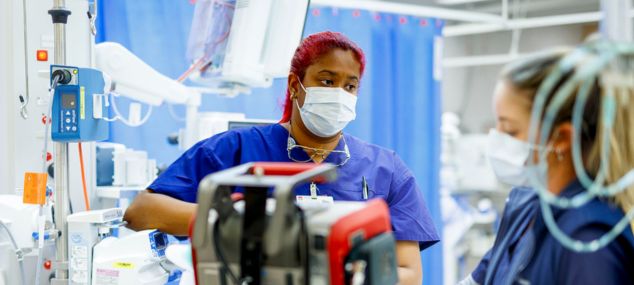
The latest Bureau of Health Information Healthcare Quarterly report shows a record number of patients attended Northern NSW Local Health District (NNSWLHD) emergency departments during the final quarter of 2024, with nearly 60,000 attendances, up 2.9 per cent (or 1,670) compared to the same quarter in 2023.
The majority of patients across NNSWLHD started treatment on time (67.7 per cent).
Tweed Valley Hospital was the busiest hospital in the District, with 15,153 attendances in the quarter, an increase of 4.6 per cent (or 672) compared to the same quarter the previous year and the highest number of attendances on record.
NNSWLHD hospitals also recorded the most ambulance arrivals on record during this quarter, an increase of 5.3 per cent compared to the same quarter the previous year, or 10,176 patients. The percentage of patients transferred from ambulance paramedics to ED staff within the 30-minute benchmark time remained stable at 78.7 per cent.
NNSWLHD continues to invest in strategies to improve the timeliness for patients presenting to Emergency Departments by escalating patient flow and prioritising discharges across all clinical disciplines. Some of these strategies include investing in patient flow discharge concierges, consistently reviewing emergency care assessment and treatment protocols, as well as implementing and supporting systems to avoid ED presentations, for example Urgent Care Centres and Hospital in the Home.
All patients are seen and triaged on arrival at the ED and, as always, the most seriously unwell patients are treated first. During busy times, people with less urgent conditions can experience longer wait times when there are large numbers of seriously unwell patients being prioritised for emergency care.
NNSWLHD performed 3,326 planned surgeries during the quarter, with 82.6 per cent of these surgeries performed on time, an improvement of 6.6 percentage points compared with the same quarter in 2023.
Almost 80 per cent (79.9 per cent) of semi-urgent and 79.4 per cent of non-urgent planned surgeries were performed on time, an improvement of 8.8 and 9.5 percentage points compared to the same quarter the previous year, respectively.
Any patient who feels their condition may have deteriorated while waiting for their surgery is encouraged to contact their treating doctor who can review their condition and place them in a higher urgency category, if appropriate.
NNSWLHD continues to remind everyone to support us by saving emergency departments and ambulances for saving lives. If an illness or injury is not serious or life-threatening, we encourage people to call Healthdirect Australia on 1800 022 222, for 24-hour telephone health advice.
INDIVIDUAL HOSPITAL RESULTS
BALLINA DISTRICT HOSPITAL had 4,872 ED attendances during the quarter. More than seven in 10 patients (70.9 per cent) left the ED within four hours. More than eight in 10 patients (84.8 per cent) were transferred from ambulance to ED staff within the 30-minute benchmark.
BYRON CENTRAL HOSPITAL had 6,191 ED attendances throughout the last quarter of 2024 (an increase of 2.6 per cent on the same quarter last year). The majority of patients (77.9 per cent) started their ED treatment on time, and eight in 10 patients (81.9 per cent) left the ED within four hours of arriving. More than nine in 10 patients (93.0 per cent) were transferred from ambulance to ED staff within the 30-minute benchmark.
CASINO & DISTRICT MEMORIAL HOSPITAL had 3,605 ED attendances in the quarter. More than eight in 10 patients (83.5 per cent) left the ED within four hours of arriving. More than nine in 10 patients (96.7 per cent) were transferred from ambulance to ED staff within the 30-minute benchmark.
GRAFTON BASE HOSPITAL had 7,536 ED attendances during this quarter (an increase of 4.9 per cent on the same quarter last year). Almost seven in 10 patients (68.7 per cent) left the ED within four hours. More than eight in 10 patients (83.5 per cent) were transferred from ambulance to ED staff within the 30-minute benchmark.
LISMORE BASE HOSPITAL had 10,554 ED attendances during the quarter (an increase of 2 per cent on the same quarter last year), and a significant increase (18.6 per cent) in the number of patients requiring emergency care (triage category 2), compared to the same quarter in 2023. The majority of patients (61.1 per cent) were transferred from an ambulance to ED within the 30-minute benchmark.
MACLEAN DISTRICT HOSPITAL had 4,330 ED attendances during the quarter (a significant 10 per cent increase compared with the same quarter last year). The majority (74.2 per cent) started their treatment on time and more than eight in 10 (86.5 per cent) patients left the ED within four hours. More than nine in 10 patients (92.7 per cent) were transferred from ambulance to ED staff within the 30-minute benchmark.
MURWILLUMBAH DISTRICT HOSPITAL had 5,396 ED attendances during the quarter (an increase of 3.3 per cent on the same quarter the previous year). More than eight in 10 (86.1 per cent) patients started their treatment on time, and more than eight in 10 patients (87.0 per cent) left the ED within four hours of arriving. Almost all patients (96.7 per cent) were transferred from ambulance to ED staff within the 30-minute benchmark.
TWEED VALLEY HOSPITAL had 15,153 ED attendances during the quarter (an increase of 4.6 per cent on the previous year), the highest on record. The majority of patients (76.5 per cent) started their treatment on time, which is significantly better than the average (58.1 per cent) for hospitals of a similar size in NSW. Two thirds (66.6 per cent) of patients left the ED within four hours of arriving, and more than eight in 10 patients (84.8 per cent) were transferred from ambulance to ED staff within the 30-minute benchmark.